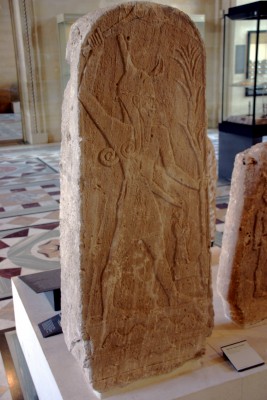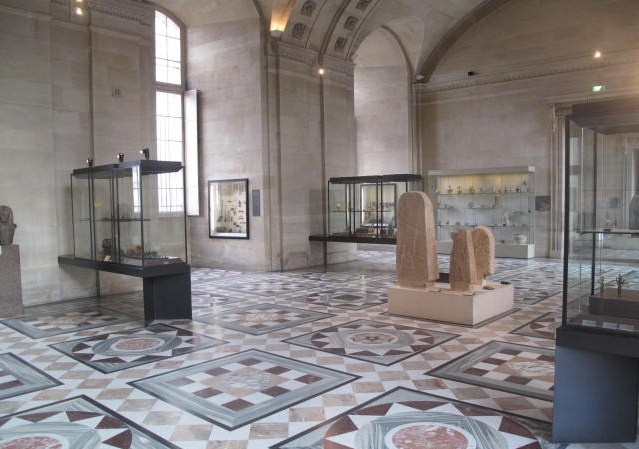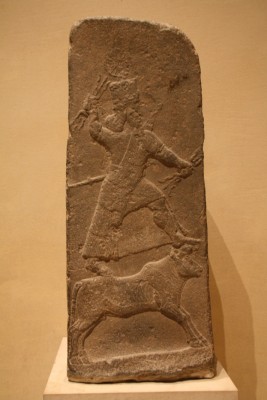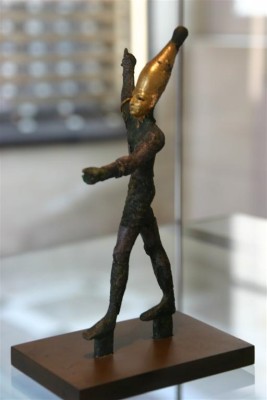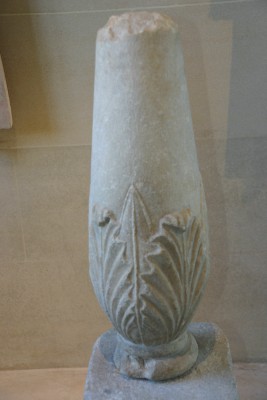Un jour, Une Œuvre,
24/02
Stele of the Storm God Baal
AO 15775 Sully Levant room B This relief is one of the most remarkable representations of Baal Hadad, ‘Rider of the Clouds’ and ‘Lord of the Earth’. Facing right, the storm god is brandishing a club with which he is smashing the clouds; lightning accompanies the storm showers which fertilise the countryside. The supreme divinity of this pantheon of over 200 gods and goddesses was El, personified as an old, white-bearded wise man, and willingly distant from humankind unlike Baal.
Stele of the Storm God Baal,
a remarkable representation of Baal Hadad
For the Canaanites, only Baal could preserve them from drought and death, incarnated by the god Mot. It appears that Ugaritic religion shared many similarities with that of the neighbouring Canaanites.
The texts from Ras Shamra
bear witness to the damaging
effects of this cult of divinities,
the accent being placed on war,
sacred prostitution and sex,
with the social degradation
that goes with it.
In Ugarit, we are far from
the moral and ethical heights
reached in the Bible.
From that moment on, the laws given to ancient Israel, which notably condemned magic and astrology A290, bestiality (Leviticus 18:23) and ritual cutting (1 Kings 18:26; Leviticus 19:28), acted as a shield against the base acts of the cult of Baal.
On several occasions, the biblical text mentions “the Baals and images of Ashtoreth” that the Israelites used after having abandoned Yahweh (1 Samuel 12:10). This general name applied to the divinities of the Canaanite pantheon, the iconography and onomastics into which there is currently better insight. A291 The text of Judges 10:6 confirms the accuracy of the geographical information: “They began to serve the Ba´als and the Ash´to·reth images and the gods of Syria and the gods of Si´don and the gods of Mo´ab and the gods of the sons of Am´mon and the gods of the Phi·lis´tines.”
Stele Representing the Storm God Adad
AO 13092 Time of Tiglath-Pileser III 744-727 BC. Richelieu Mesopotamia room
The term hab-Baal is applied to these false gods. The expression hab-Bealim (the Baals) refers to various local divinities considered to be ‘owners' or ‘lords’. The word appears just once in the Greek Scriptures where it is preceded by the feminine article (Romans 11:4). Commenting on this usage, John Newton says that, “In the licentious cult of this androgynous god, the men wore female dress, while the women dressed as men and brandished weapons” A292 On several occasions, the Bible establishes a link between the heavenly bodies and the worship of Baal.- 2 Kings 17:16
Baal Brandishing Lightning AO 11598
14th-12th Centuries BC, port of Ugarit room B showcase 8
Cippus AO 4818
Sully room 18 b
The bilingual Greek and Phoenician dedication, “To Melqart, Baal of Tyre”, on this small marble column is at the origin of the deciphering of Phoenician and Punic texts in 1758. Under the influence of his pagan wife Jezebel, King Ahab introduced a different form of Baal worship into Israel: that of Melqart, the Baal of Tyre. 1 Kings 16:30-33 Joseph speaks of Ethbaal,
the father of Jezebel, under
the name of Ithobaal and specifies
that he was initially Astarte's priest
before murdering the king in order
to take over his throne. A294
Worship of Baal : immoral fertility rituals and sexual orgies
The Hebrews learnt about the worship of Baal through Canaanite farmers. (Judges 2:11) At the start of the rainy season,
Baal’s return to life to regain
the throne and to unite with
his paredra was famous due to
the immoral fertility rituals, characterised by sexual orgies
that knew no limit. A293 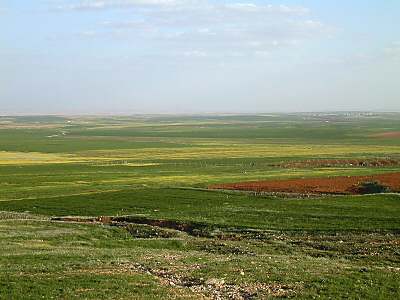
Moab’s fields south of Arnon
www.bilblePlaces.com
The Hebrews learnt about the worship of Baal
through Canaanite farmers.
This spiritual battle with the hearts of the Israelites at stake lasted centuries, from the arrival on the plains of Moab to the deportation to Babylon. On one side lay superstitious fear and sexual rituals and, on the other, faith and fidelity towards the true God. This was a conflict which serves as an example and warning to Christians. - 1 Corinthians 10:11. Similarities have been noted between the texts of Ras Shamra and the Bible. However, this connection is purely literary and not spiritual. In Ugarit, we are far from the moral and ethical heights reached in the Bible.
